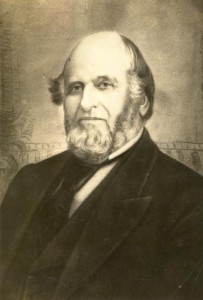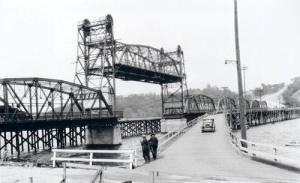Pioneer Era Territorial Period Early Statehood Lumber Era World Wars Modern
Pioneer Era
1837
July 29 – Treaty with the Ojibwe –
Twelve hundred Ojibwe gather at Fort Snelling to sign a treaty with Governor Henry Dodge of Wisconsin Territory, ceding lands between the Mississippi and St. Croix Rivers. This treaty leads to the opening of today’s Washington County for settlement and lumbering. In exchange for this land, the Ojibwe are paid twenty yearly installments of $9,500 cash, $19,000 in goods, $2,000 in provisions, $3,000 to establish and maintain three blacksmiths’ shops, and $500 worth of tobacco.
September 26 – Treaty with the Dakota – 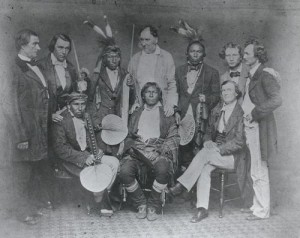
A treaty is signed in Washington D.C. between Secretary of War Joel Poinsett and leaders of the Mdewakanton Dakota, who cede lands east of the Mississippi for $300,000. This amount is paid in yearly installments consisting of $5,000 cash, $10,000 goods $8,250 for agricultural implements, medicines and support of a physician, blacksmiths, and farmers, plus $5,500 in provisions. The Dakota are required to move further west.
1838
September 29 – Hone and Judd Arrive in Stillwater
The steamboat Ariel lands an exploring party at Stillwater including Illinois entrepreneurs David Hone and Lewis Judd. These men, sent on an expedition from Marine Settlement in Illinois, had been exploring the St. Croix River to choose a potential millsite. After disembarking at Stillwater, Hone and Judd pole a flatboat upriver and eventually stake a claim at the site of today’s Marine on St. Croix.
1839
July 4 – Battle between Dakota and Ojibwe
Two groups of Dakota and Ojibwe meet in battle in a ravine just north of Stillwater. The conflict begins on July 2, when a son-in-law of the Dakota band, named Meekaw, is killed and scalped by two Ojibwe of the Pillager band near Lake Calhoun. This act begins to stir unpleasant sentiments among the Dakota and war parties are immediately sent out in pursuit. On July 3, the Kaposia band of Dakota finds the St. Croix Ojibwe in a ravine just north of today’s Stillwater – they attack. By the end of the encounter twenty-one Ojibwe lay dead with another twenty-nine wounded. However, the Dakota suffer no casualties. The location of this skirmish becomes known as “Battle Hollow,” and later becomes the site of the Minnesota Territorial Prison.
August 24 – First Lumber Cut
The first lumber is cut at the Marine Mill, marking the start of Minnesota’s lumber industry.
1840
January 9 – St. Croix County Created
The new county of “St. Croix” is created by the Territorial Legislature of Wisconsin, incorporating today’s Washington County. “Dakotah”, Joseph Brown’s settlement, is chosen as the county seat.
August 3 – First County Election 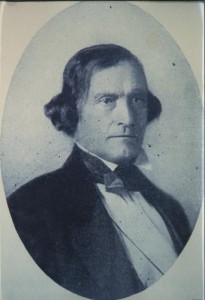
St. Croix County, including today’s Washington County, holds its first county election. The sites receiving votes are Joseph Brown’s warehouse (at today’s city of Stillwater, Minnesota), and Philander Prescott’s claim (at today’s city of Prescott, Wisconsin). Brown himself is elected as register of deeds, treasurer, and surveyor. Three county commissioners are also elected: Hazen Mooers of Grey Cloud Island, Calvin Tuttle of St. Croix Falls, and Samuel Burkleo of Marine .
1841
June 29 – First White Woman in the Valley
“Early in the interview she [Lydia A. Carli] made it clearly understood that she wished to deal exclusively in facts; that many things had been published in reference to olden times that were fictitious, foolish and filled with vanity and vexation of spirit.” Lydia A. Carli landed at Grey Cloud Island May 13, 1841 and arrived at Joseph Brown’s, her half-brother’s settlement of Dakotah just north of present-day Stillwater. Lydia will remain in the area for the remainder of her life. On March 12th, 1847 she married Dr. Christopher Carli, the first non-military physician to practice medicine west of the St. Croix River.
1843
October 10 – Machinery Arrives for McKusick Mill
Machinery arrives in Stillwater for John McKusick’s mill. McKusick himself, along with his entrepreneurial partners, Elam Greeley, Calvin Leach, and Elias McKean, meet in St. Louis to purchase the machinery. It is shipped on the steamer St. Louis Oak to Galena, Illinois, where it is transferred to the Otter. On October 26th, this equipment is used in the formation of the Stillwater Lumber Company. This event will later be used to mark the beginning of the settlement of Stillwater. The name is chosen by McKusick himself because of the stillness of Lake St. Croix and fond boyhood memories of Stillwater, Maine.
1846
January 14 – Stillwater’s First Postmaster
Elam Greeley becomes the first postmaster at Stillwater.
1847
December 20 – Site Provided for Stillwater Courthouse
John McKusick deeds the land on the corner of Chestnut and Fourth Streets to the City of Stillwater. This land is chosen as the site for a courthouse and construction is completed in August of 1849. This building serves the county well for over 15 years, until the larger Washington County Courthouse is built upon “Zion’s Hill” in 1870.
1848
March 13 – Wisconsin Becomes a State
Wisconsin becomes a state with a border extending to the St. Croix River. No provision is made for a Minnesota Territory, leaving eastern Minnesota as a no-man’s land without any formal government.
August 26 – Territorial Convention
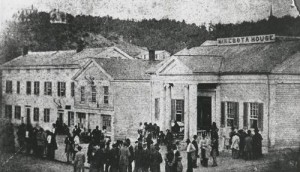 Concerned with their lack of legal organization, a group of Stillwater citizens meet on August 6th and call a convention to convene on in Stillwater on August 26th to determine their course of action. These delegates pass a resolution for Henry Sibley to travel to Washington DC and submit a request that the United States Congress organize a new territory named “Minnesota”. Because of this convention, Stillwater will become known as the “Birthplace of Minnesota”. Photograph:
Concerned with their lack of legal organization, a group of Stillwater citizens meet on August 6th and call a convention to convene on in Stillwater on August 26th to determine their course of action. These delegates pass a resolution for Henry Sibley to travel to Washington DC and submit a request that the United States Congress organize a new territory named “Minnesota”. Because of this convention, Stillwater will become known as the “Birthplace of Minnesota”. Photograph:
September 12 – Stillwater Platted
Stillwater is surveyed and platted by Harvey Wilson.
Territorial Period
1849
January 15 – Sibley Arrives in Washington
Henry Hastings Sibley is seated in Washington as a delegate from the equivocal section of Wisconsin Territory left out when the state of Wisconsin was created. With the help of the well-known politician Stephan A. Douglas, Sibley is able to pilot his bill through Congress and the Territory of Minnesota is formally created within two months.
March 3 – Minnesota Territory Created
Responding to the Stillwater Convention, the United States Congress organizes Minnesota Territory with the St. Croix River as an eastern boundary and the Missouri River as a western boundary. The area of today’s Washington County is the only part of the territory with structured government.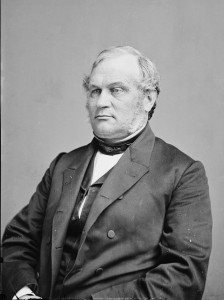
May 26 – Alexander Ramsey Arrives in Stillwater
Alexander Ramsey, the newly appointed governor of Minnesota, steps ashore at Stillwater. Before making his way to St. Paul, he tours the county, speaking with local businessmen and community leaders. He meets and promotes John McKusick to marshal of Minnesota Territory.
June 1 – Stillwater Holds District Court
Alexander Ramsey’s first act as Governor of Minnesota Territory is to institute three judicial districts. Stillwater is set to hold the District 1 Court on the second Monday in August. On August 13th, 1849, the first Minnesota Supreme Court meets in Stillwater.
August 15 – Odd Fellows Organized
Minnesota Lodge No. 1, I.O.O.F. (Odd Fellows) is organized in Stillwater.
September 3 – First Territorial Legislature is Held
Minnesota’s first Territorial Legislature, is summoned by the newly appointed Governor Alexander Ramsey. The assembly, held in the dining room of a St. Paul hotel, features several early settlers of Washington County. As one of its first acts, the legislature pursues the establishment of a system of free education.
October 27 – Washington County Established
Washington County is established by the first Minnesota Legislature as one of nine original counties into which Minnesota Territory is divided. Originally organized in 1840 as St. Croix County, Wisconsin Territory, this county originally included all of Minnesota east of the Mississippi River as well as part of Wisconsin. In order to prevent having two St. Croix Counties facing each other across the river, the legislature grants the name “Washington” to the county after the country’s first president.
November 26 – First Election
During the first election of the new county the following board of county officers were elected: Commissioners, John McKusick, Hiram Berkey, Joseph Haskell; treasurer, Socrates Nelson; register of deeds, John S. Proctor; judge of probate, Harvey Wilson; sheriff, Jesse Taylor. At the same election the following persons were elected justices of the peace in their various precincts: St. Croix Falls, Jerry Ross; Point Douglas, Martin Leavitt; Stillwater, Albert Harris and H.K. McKinstry; Marine, James Moore and W.H. Johnson.
1850
October 18 – First Swedish Settlement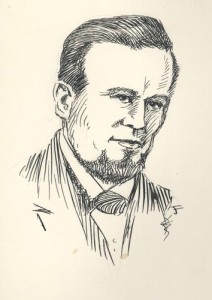
The first Swedish settlement in Minnesota is built by Carl Fernstrom (right), Oscar Roos, and August Sandahl. Carl, the son of a Swedish lawyer from Skara, Vastergotland, Sweden had studied theology at Uppsala University before immigrating to America with his close friend Oscar Roos. Upon their arrival to the U.S., the two Swedes originally settled in Illinois. Carl then traveled to Minnesota where he scouted out the land in the Scandia area. He then returned to Illinois to convince Oscar and another newly-arrived Swede, August Sandahl, to join him in Minnesota. The three stake a claim of forty acres and build a log cabin.
1851
February 7 – Boom Company
The Minnesota Territorial Legislature organized the Boom Company. After several unsuccessful previous sites, it was placed about a mile north of Stillwater on the St. Croix River.
May 23 – Location Selected for Minnesota Territorial Prison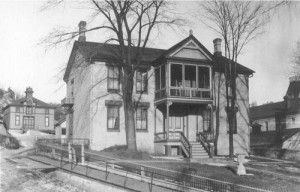
The Board of Commissioners of Public Buildings for the Territory of Minnesota selects four acres of land on the north end of Stillwater for the site of the Territorial Prison and Warden’s House. Land is purchased from John McKusick and Christopher Carli for $100 an acre. Both the Prison and the Warden’s House are occupied from 1853 to 1914. The next day on May 24, the Territorial government announces that they will accept bids for the construction of the prison on June 24th. The bid would include both the materials and labor and required, the “Prison to be [made] of stone, and the cost not to exceed forty thousand dollars ($40,000).”
1852
May 13 – Stillwater Landslide
Early in the morning, Stillwater citizens are awakened by a deafening, rushing noise. Looking out, they see a vast river of softened earth, slowly descending through the ravine. It proceeds to cover all objects in its path, nearly burying entire buildings. It moves onward into Lake St. Croix and there deposits eight to ten acres of new land, adding a permanent addition of land to the town as well as a fine steamboat landing.
September 18 – First Swedish Bride
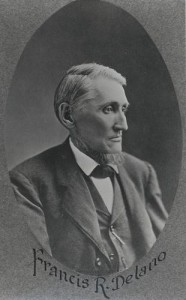
March 4 – Francis R. Delano Becomes First Warden
Francis R. Delano is named first Warden of the Minnesota Territorial Prison. He continues to serve until March 4, 1858.
1854
March 4 – Stillwater Incorporated
Stillwater and St. Paul are incorporated as cities in the Minnesota Territory.
April 13 – Preparations for Schulenburg and Boeckeler Mill
 Originally from St. Louis, Frederick Schulenburg and Adolophus Boeckeler arrive in Stillwater to look for land and a site for a lumber mill. On April 13, Minnesota Pioneer editor Joseph R. Brown comments that “Messrs. Schulenburg, Boeckeler & Co. are making preparations for the erection of an extensive mill in the upper part of town, to run some twelve saws…” It would take several months of construction before the mill would be ready to commence operations.
Originally from St. Louis, Frederick Schulenburg and Adolophus Boeckeler arrive in Stillwater to look for land and a site for a lumber mill. On April 13, Minnesota Pioneer editor Joseph R. Brown comments that “Messrs. Schulenburg, Boeckeler & Co. are making preparations for the erection of an extensive mill in the upper part of town, to run some twelve saws…” It would take several months of construction before the mill would be ready to commence operations.
May 19 – Elim Lutheran Church Organized
The Marine Congregation is organized at a meeting in Daniel Nilson’s log cabin on the shores of Hay Lake in Scandia. Pastor Erland Carlson, a church planter from Chicago presides over the meeting and the first deacons of the congregation are appointed: Bengt Johnson, E. Erickson, and C. A. Ljungren. The Marine Congregation proceeds to change its name a number of times and is now known as Elim Lutheran Church.
June 1 – Construction of Isaac Staples Mill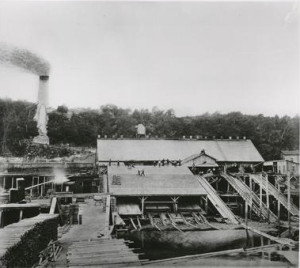
Isaac Staples begins to construct his first mill on the south end of Main Street in Stillwater. He organizes the Hersey, Staples, and Company with partners S. F. Hersey, Dudley C. Hall, George A. Whitney, and John Brooks Fenno. Once the mill is completed, it contains one muley saw, three sash saws, one live gang saw, and one small circular saw.
1855
November 25 – Elim Lutheran Church Building Planned
A meeting is held at Scandia settler Daniel Nilson’s home to discuss the construction of a permanent home for Elim Lutheran Church. The first church building, a log structure, is erected in 1856 and still stands today at the Gammelgården museum in Scandia.
December 8 – Territorial Prison Report
The St. Croix Union writes about the Territorial Prison: “We dropped into this ‘institution’ a day or two ago and gathered some facts that may interest some of our readers. A new building, during the past season, has been erected, at a cost of something over $5,000. At the earnest solicitation of Hon. H.M. Rice, Uncle Samuel furnished the wherewithal. A nice old fellow is Uncle Sam – isn’t he? Within the shop buildings is a great variety of machinery; and in nearly every instance, steam is the motive power. Accompanied by Mr. Delano, the gentlemanly Warden, we passed through several departments of the buildings, and saw some of the machinery in motion. At this present writing there is but one convict in the penitentiary, and he seemed to do his work more leisurely than any other operative whom we saw employed. Had not one side of his head been shaved we should not have known that he was a convict.”
1856
May 2 – Temporary Shut-Down of McKusick Mill
Despite the decisions of other Stillwater mills to install steam generators, the McKusick Mill continues to use the water wheel, resulting in occasional break-downs. According to the St. Croix Union, “The McKusick mills are not now running. The Lake has risen and backed up into the mill so that the water–wheel cannot revolve.” Fortunately, the mill begins to operate again within three weeks.
June 27 – Mass Prison Escape
The St. Croix Union reports on the mass escape at the Minnesota Territorial prison. “We are informed that one day this week every prisoner and convict in the penitentiary made his escape, and up to Thursday noon they had not been recaptured. We censure no one because we do not know that anybody should be censure; but the fact that they have escaped is humiliating to us as a community.” The escape was partly possible because of the mismanagement of the warden of the time, Frances Delano. Later wardens will work to improve the security of the prison.
Early Statehood
1857
February 26 – Minnesota Allowed Admission as a State
President Franklin Pierce signs an enabling act, allowing for Minnesota’s admission as a state. Within a few days, Congress passes another bill providing land grants for Minnesota railroads. As a result, a railroad line is planned to extend from St. Paul to Stillwater.
1858
February 8 – Fossil Remains
As statehood approached for Minnesota, Stillwater was preparing herself as one of its leading cities. On Monday, February 8, 1858, the fossil remains of a mastodon were discovered by a work crew excavating Myrtle Street. The tusks were found about eight to ten feet above the base of the hill of Myrtle Street and 36 feet below the ground.
March 19 – “Iron Horse” Celebration
Warden Delano of the prison was in charge of the festivities welcoming the first “iron horse” to the St. Croix Valley. He called for a general illumination of every building in the city declaring that one candle was to be placed behind every pane of glass. There was music, sky rockets, and all sorts of pageantry. The St. Paul Daily Times called the event “one of the grandest and most imposing scenes we have ever witnessed.” However it all turned out to be a false hope. The depression of 1857 put an end to railroad dreams and the St. Croix Valley had to wait until 1867 when a tired and discouraged Stillwater formed an independent company of its own and built the Stillwater-White Bear Road. Only then did the Iron Horse finally reach the valley.
May 11 – Minnesota Becomes a State
Minnesota becomes the 32nd state of the United States.
October 20 – Lakeland Organized as a Town
Lakeland is officially organized as a town. The first board of supervisors consisted of Charles A. Oliver, Elias McKean, and A.D. Kingsley.
1859
June 17 – Grand Military Display
The Stillwater Guards militia company presented a Grand Military Display that featured a review by Governor Henry Sibley, a grand parade with the Washington Artillery and the pioneer Guards of St. Paul, all followed by a grand Brass band, parties present from all over, and no expense spared it was the occasion of the season.
1861
April 22 – Call for Union Army Volunteers
A meeting is held at Lakeland in reply to President Lincoln’s call for 75,000 Americans to join the Union Army. Only five local men volunteer. However, after a mass meeting and rousing speeches in the next week, dozens of Washington County citizens join Union forces. By 1864 approximately 511 Washington County men are members of the Union Army.
April 29 – Company B of the First Minnesota Organized
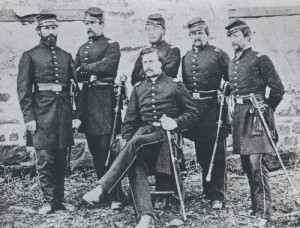 A militia group, the Stillwater Guard, is reorganized into Company B of the Minnesota First Regiment at Fort Snelling, comprising of 101 men from Washington County. This unit, captained by Mark Downie and Lewis Muller, includes three command officers, five sergeants, eight corporals, eighty-two privates, two musicians, and a wagon master. Of these 101, only twenty-seven safely return home following the war.
A militia group, the Stillwater Guard, is reorganized into Company B of the Minnesota First Regiment at Fort Snelling, comprising of 101 men from Washington County. This unit, captained by Mark Downie and Lewis Muller, includes three command officers, five sergeants, eight corporals, eighty-two privates, two musicians, and a wagon master. Of these 101, only twenty-seven safely return home following the war.
1862
January 21 – First Flour Ground
The first flour that was ground in the McKusick mill was on this day.
July 25 – Call for Union Reinforcements
A war meeting is held in Stillwater to raise volunteers in response to the Union’s desperate cry for reinforcements. Although scores of young men from Washington County had already enlisted in Union Forces, many more answer this call, and five new regiments, the Sixth through the Tenth, are formed.
1863
June 2 – North Hill Cemetery in Poor Condition
Because of the poor condition of the North Hill Cemetery, the Stillwater Messenger reports: “The gates are down so that cattle range at large over the grounds, breaking down the shrubbery and tomb stones. A large part of the grounds is growing up to bushes which, in a few years, if not attended to, will become an impenetrable thicket.”
July 2 – Sacrifice of First Minnesota at Battle of Gettysburg
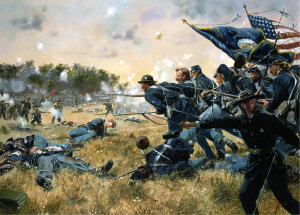 The Minnesota First Regiment Company B, furnished with dozens of troops from Washington County, meets the Confederate Army in the second day of the Battle of Gettysburg. Once the Confederate Army brakes through with a mighty force, the members of Company B, on a reserve position on the Union line, are among the few able to fill the gap. They make a noble sacrifice and charge the enemy head-on. At the end of this bloody affair, Corporal Adolphus Hospes writes, “Our company has only six men left for duty. Four dead, 23 wounded besides both of our officers. Our colonel, lieutenant colonel, (and) Major Downie are all three badly wounded. Captain Muller and three other captains of the regiment are among the killed.”
The Minnesota First Regiment Company B, furnished with dozens of troops from Washington County, meets the Confederate Army in the second day of the Battle of Gettysburg. Once the Confederate Army brakes through with a mighty force, the members of Company B, on a reserve position on the Union line, are among the few able to fill the gap. They make a noble sacrifice and charge the enemy head-on. At the end of this bloody affair, Corporal Adolphus Hospes writes, “Our company has only six men left for duty. Four dead, 23 wounded besides both of our officers. Our colonel, lieutenant colonel, (and) Major Downie are all three badly wounded. Captain Muller and three other captains of the regiment are among the killed.”1864
March 7 – Permission to Build Stables for Warden’s House Granted
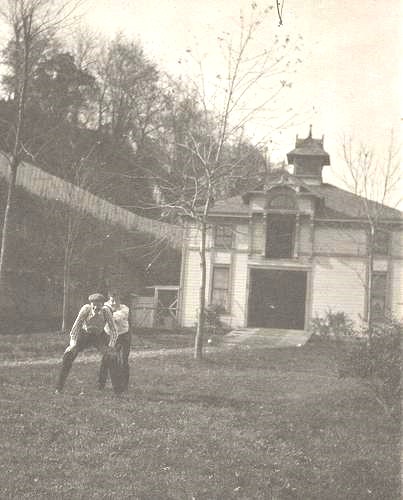 Warden John S. Proctor, who superintended the Minnesota Territorial Prison from January 1, 1860 to February 16, 1868, is granted permission to build a 24 x 24 foot stable on the lot adjoining the Warden’s House. The construction of the stable is completed in July by J.E. McKusick who is paid $75 for the job. The stables eventually evolve into a two-story framed carriage house. By 1910 the carriage house is used as a automobile garage. The building is removed in 1914, the same year that the prison is abandoned.
Warden John S. Proctor, who superintended the Minnesota Territorial Prison from January 1, 1860 to February 16, 1868, is granted permission to build a 24 x 24 foot stable on the lot adjoining the Warden’s House. The construction of the stable is completed in July by J.E. McKusick who is paid $75 for the job. The stables eventually evolve into a two-story framed carriage house. By 1910 the carriage house is used as a automobile garage. The building is removed in 1914, the same year that the prison is abandoned.
1865
July 14 – First National Bank Organized
The First National Bank of Stillwater was organized July 14, 1865.
November 8 – Purchase of Sawyer and Heaton Mill
Purchase of Sawyer and Heaton mill Samuel J. Atlee & Company purchases the second mill built in Stillwater. Constructed in 1850, this mill was originally owned by Seth M. Sawyer and Alvah Heaton. In 1853, Heaton sold his portion to William Lowell and the firm name changed to Lowell and Sawyer. Upon Lowell’s retirement, Clay and Sawyer conducted the business until 1865 when it was sold to Samuel J. Atlee & Company, who operated the mill for three years.
1867
October 31 – First Cemetery Association Meeting
The first meeting of the Cemetary Association is held in response to a call for such an organization made earlier by the Stillwater Messenger. A committee made up of Isaac Staples, R. Lehmick, and A. B. Stickney is appointed to “select some suitable grounds for a cemetery.” Land is selected for the cemetery on South Fourth Street in Stillwater and is given the name “Fairview.”
Lumber Era
1869
July 16 – Isaac Staples Purchases Mill
Isaac Staples purchases the mill originally built by Seth M. Sawyer and Alvah Heaton for $15,000. The name of the company is changed to St. Croix Lumber Mills. Staples completely remodels the mill and it enjoys prosperity under his command. He eventually constructs a flourmill 40 x 50 feet and four stories high next to the lumber mill. This new venture is called the St. Croix Flouring Mills.
1870
August 2 – First Railroad Station
Construction of the main railroad line from St. Paul to Duluth is completed and Washington County’s first railroad station is established in Forest Lake at West Broadway Avenue.
1871
May 19 – Construction of Chestnut Street Stairs
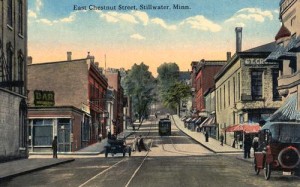 The Stillwater Messenger reports that, “A new stairway is being built on Chestnut Street, leading from Third Street to the old Court house hill.” These stairs would prove helpful for the residents of Stillwater as the stairs led from the town to the more residential areas.
The Stillwater Messenger reports that, “A new stairway is being built on Chestnut Street, leading from Third Street to the old Court house hill.” These stairs would prove helpful for the residents of Stillwater as the stairs led from the town to the more residential areas.
June 30 – Close of McKusick Lumber Mill
Upon the demise of the McKusick Lumber Mill, the editor of the Stillwater Messenger writes this eulogy for the mill: Thus, having withstood the elements, ’lo, these many years,’ it is forced to give way to the march of improvement, and be ruthlessly torn down by the hand of those who little think or care for its age or crepitude. So it is with us all. A little life and activity, and then we are hid away among the numbered million of the dead, soon to pass from memory and be forgotten. We may well ask, with Rip Van Winkle: ‘Are we so soon forgotten when we are gone?’
1872
February 10 – Opening of Railroad Line
In January of 1872 the tracks of the St. Paul, Stillwater & Taylor’s Falls Railroad (SPS&TF) and the West Wisconsin came together at what became known as Stillwater Junction in Baytown. The rails soon reached Stillwater from the south and by February the line was through to the Lakeland bridgehead. Stations were built at Oakdale and Bass Lake (Lake Elmo). The opening of the line was celebrated February 10, 1872, with a grand party at the Metropolitan Hotel in St. Paul following an excursion from St. Paul through Lake Elmo to Stillwater and back. Numerous dignitaries addressed the crowd. A week later the West Wisconsin leased the Hudson branch, and the next month gained the right to operate in Minnesota. The SPS&TF never owned a locomotive and never went to Taylor’s Falls. The general manager of the road was Alpheus B. Stickney, who was prominent in promoting Lake Elmo as a resort stop.
1873
June 11 – World’s Fair Comes to Stillwater
The World’s Fair and Trans-Atlantic Exposition come to Stillwater for one day.
1875
September 10 – Construction of Main Street Stairs
The Stillwater Lumberman states that, “In accordance with instructions from the city council, the street commissioner is constructing a new series of steps from Main Street to Broadway, near the Brewery of Wolf, Tanner & Co. The new ones are to be located about twenty feet from the brewery, making it much more pleasant for those who have occasion to travel up and down them.”
1876
May 9 – First Stillwater Bridge Opens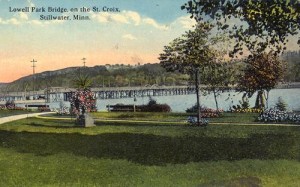
The first bridge that spans the St. Croix River at Stillwater opens.
November 22 – Younger Brothers arrive at the Stillwater Prison
The notorious Younger Brothers — Cole, Jim, and Bob — enter the Stillwater Prison serving life sentences after the failed Northfield Bank Raid.
1877
May 16 – Schulenburg, Boeckler & Co. Lumber Mill Fire
The Schulenburg, Boeckler & Co. lumbermill burned down for the first time. The mill was rebuilt, but burnt down again causing bankruptcy.
1881
May 11 – Grand Opera House Opens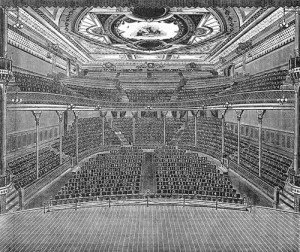
Stillwater’s new Grand Opera House opens. In 1888, author W.H.C. Folsom described it in his Fifty Years in the Northwest as follows: “The opera house occupies the site of the old Lake house, on Main street between Nelson and Chestnut streets. It was commenced in 1880 and finished in 1881, under the supervision of L.W. Eldred, architect. Its size is 90 x 120 feet, ground plan, and four stories in height, or seventy-one feet from lower floor to cornice. The style of architecture is a blending of the Queen Anne, Victoria and Gothic. The entrance to the upper part of the building is a stairway twelve feet wide, in a lofty, ornamental turret. The auditorium is 64×120 feet, and beautifully and elaborately finished and furnished, and is capable of seating over 1,200 persons. It is well lighted, being supplied with 130 gas jets, warmed by steam, and well ventilated. The stage is 39×64 feet, complete in all its appointments, and supplied with all the necessary stage scenery, wings, border bridge, balcony, interior and other decorations. The ceiling of the auditorium is superbly frescoed and the cornice is adorned with medallions of Shakespeare, Haydn, Schiller, Goethe, Dickens, Handel, Scott, Longfellow, Mozart, Tennyson, and Beethoven. The parts of the building not occupied for stage purposes are apportioned to halls, offices and stores.” Over the years, the Grand Opera House hosts a plethora of amusements, including everything from plays, operas, and masquerades, to boxing exhibitions, the John Phillip Sousa Band, and even Buffalo Bill’s Wild West Show. The opera house was destroyed by fire in 1902.
September 18 – Dellwood is Named
Property on the northeast shore of White Bear Lake finally came before the public eye. Augustus Kirby Barnum in whose interest Horton was acting, registered the plat. It was a family affair, as Barnum’s wife, Carrie Josephine, cosigned the document, and his half-brother, William Hewitt, acted as witness and notary. Named the plat Dellwood.
1883
June 1 – Isaac Staples Sells Mill
Stillwater lumber giant Isaac Staples sells his mill to the Northwestern Manufacturing and Car Company. Two months later, they in turn sell the flour milling portion to J.H. Townshend for $54,200. Like Staples, Townshend enjoys success in this venture for many years. He operates the mill until his death in June 27, 1888.
August 6 – Bells of St. Michael’s
Stillwater residents hear for the first time the breathtaking melody produced by the colossal six-ton, ten-bell chimes of St. Michael’s Church. These are the first chimes of this caliber in the northwest and are operated by Mamie Hoy, the first and only woman to have the privilege of operating the ropes of the gigantic mechanism. The chimes would continue to be heard in their original form until Christmas Day, 1962. The chimes are still heard today, although the mechanism has since been electrified.
1884
May 10 – Improvement of Baseball Field
The first baseball park in Stillwater, now commonly known as the “old athletic field,” is improved in order to be in superior condition when the Northwestern League comes to play in Stillwater. The St. Paul Daily Globe says, “The base ball grounds will be put in excellent condition for the series of games, which will commence here on the 9th day of June. All of the old stumps are to be removed and the surface of the ground made smooth and level. The old amphitheater will be replaced with one of larger seating capacity. In a word, the directors are determined to furnish the public with the best possible accommodations for witnessing the games.”
1885
July 21 – Last Man Club Formed 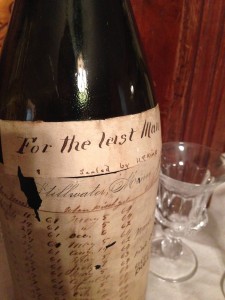
“34 survivors from Minnesota Company B of Civil War fame met and formed ‘The Last Man Club’, the first of its kind in the nation. The survivors gathered annually at the old Sawyer House, where the Lowell Inn now stands. The chairs of the departed were draped in black and the centerpiece was a bottle of wine, donated by Louis Hospes, to be consumed by the last survivor. Each year the number dwindled and the gatherings became less joyful, and in 1928 the three remaining members decided to close or disband the club. Charles Lockwood became the ‘last survivor,’ and before his passing in 1935 is quoted as saying, ‘Don’t anyone ever start another club like this.’
1886
June 7 – Formation of Woman’s Reading Club
Helen McCluer begins the Woman’s Reading Club of Stillwater. At the first meeting of the Club, McCluer is elected president and continues to hold this position for 46 years. The purpose of the club is defined as the “literary and social culture of its members, and the promotion of community interest.” Throughout the years, the Club raises funds for a variety of worthy causes, including the donation of books to libraries, the “Save the Courthouse” fund, and even the restoration of Independence Hall in Philadelphia. The Club has continued for more than a century and still holds meetings today.
1888
June 22 – Formation of Gas Company
Because of gas and oil production which was swelling throughout the Midwest, some men began to speculate the perhaps there was gas or oil in Stillwater. The pond surrounding “McKusick Spring” just west of Third Street would sometimes freeze over and green bubbles of gas could be seen frozen in the ice. When picked, these bubble of gas produces a blue flame. This led to the belief that there was natural gas in the ground. Paige Guthrie of Pittsburgh began the drilling and was among those to form a gas company. However, these efforts proved unfruitful.
1891
June 21 – Kirby Barnum’s Hotel
Most of the avid young sailors chose to settle in Dellwood. It seemed foolish to them to cross the lake to race when they had their own large dock and a first rate clubhouse lay at their disposal. In the December 1890, the White Bear Yachting Association was formed. The new association proved such a success, that it grew nearly 50 members.
1892
March 30 – Renovation of Stillwater Ballpark
The Stillwater Daily Gazette describes the renovation of the of the ballpark: “A crew of men is at work building the grand stand at the Baseball Park and will have it completed by Saturday night. The stand will hold about three hundred people and together with several other improvements will cost in the neighborhood of $350. The front is 11 feet high and the seats slope upward toward the back. It is reached by a flight of stairs and a wide passageway affords ample room for entrance and exit. A box like structure in front will be occupied by the reporters and scorers. The grandstand is 75 feet back of the home plate and the front will serve as a backstop, additional protection being given to the spectators by a wire screen…”
1893
August 12 – Logging Company Pay Cut
Prominent Stillwater logging firm Musser & Sauntry reduces rafting crew wages by twenty-five cents. This pay cut is a result of a financial panic which seized the nation in 1893. These hard-working men had previously been earning $1.50 to $2 per day.
1894
May 9 – Stillwater Washout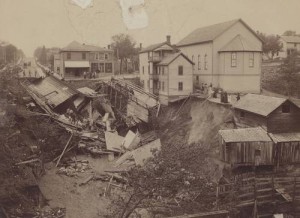
A major washout occurred on May 9, 1894 at North Fourth and Hickory Streets in Stillwater, Minnesota. The Congregational Church on the right, later became the Berglund & Peterson Grocery Store.
1895
April 9 – Opening of Inver Grove – St. Paul Park Swing Bridge
The Inver Grove – St. Paul Park Swing Bridge opens as a two–level toll bridge and is used by horses and wagons on the lower level and trains on the upper level. The bridge is built by the Pittsburgh Bridge Company for the South St. Paul Beltline Railroad. The bridge is later bought by the Rock Island Railroad, with the state renting the lower level of the bridge for vehicular traffic.
1898
May 4 – Encampment of Thirteenth Minnesota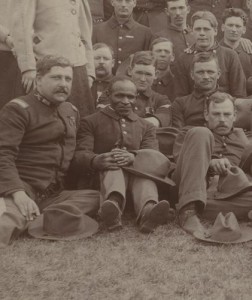
In response to America’s declaration of war on Spain, dozens of Washington County men volunteer to join the Minnesota Thirteenth Regiment, Company K for the Spanish–American War. They are encamped at the St. Paul fairgrounds, quartered four to a stall in stock barns. During their encampment, thousands of visitors stop by to see them off.
1899
August 12 – Thirteenth Minnesota Sets Sail for Home
The Minnesota Thirteenth Regiment, including many volunteers from Washington County, departs the Phillipine city of Manila for home. While in Manila, the brigade had served for nearly a year as the island police force during the Spanish–American War.
1901
April 28 – Wolf Club Baseball Game
The Joseph Wolf Baseball Club plays its first game of the season against the Minneapolis Produce Exchange team. The game is played in the Stillwater area and costs 25 cents for adults, although ladies are admitted free on the opening day.
July 13 – Funding Offer for Stillwater Public Library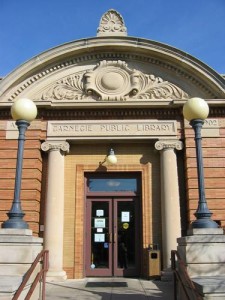
Andrew Carnegie offers $25,000 in funding for the construction of the Stillwater Public Library. Earlier that year, Stillwater resident S. Blair McBeath had written to Carnegie, telling him of the need for a public library in Stillwater. Carnegie, a former railroad giant devoted to giving to needy causes, is more than pleased to donate the needed funds. Construction soon begins and the library opens in 1903.
1902
September 17 – O.H. Olsen Chosen as Stillwater Public Library Contractor
The Stillwater Gazette announces that local contractor O. H. Olsen is chosen to build the Stillwater Public Library. Olsen’s bid for the construction of the greatly-anticipated building is $19,967 with an additional $750 for grading. The cornerstone of the library is laid two months later and the building is occupied by December 1903.
October 24 – Mill Workers Strike
The members of the trade union at the Thresher Company strike because of non-union men working on a construction job at the company. Brick and stone laborers walk out, but supervisor George Wilson quickly replaces them with non-union men.
December 5 – Opera House Burns
Stillwater’s Opera House burns to the ground. Simonet’s Furniture and Midtown Antique Mall later occupy the site.
1904
September 15 – Stillwater Bridge Burns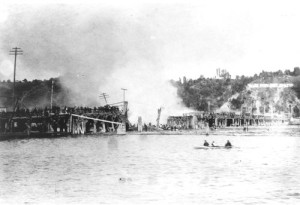
The wooden pontoon bridge across the St. Croix burns. Two people die of injuries from the fire.
1905
January 3 – Opening of Stillwater Post Office
1909
November 1 – Formation of Choral Society of Stillwater
The Choral Society of Stillwater is formed by St. Paul Symphony Orchestra violinist Mr. Walter Logan and several community members. A call for singers is sent out to area churches and the first rehearsal is held a week later with a total of 131 vocalists. Their debut performance on January 20th the following at the Stillwater Auditorium is a stunning success.
1914
June 12 – Last Log Passes Through St. Croix Boom Site
The last log goes through the St. Croix Boom site, ending nearly 75 years of logging on the St. Croix River.
World Wars
1915
March 9 – Women’s Suffrage Meeting
Mrs. F. D. Williams speaks to the Women’s Reading Club of Stillwater about women’s suffrage. Much interest is stirred at this meeting and another meeting is held on March 17 at the library. Thirty women respond by signing pledge cards to support the movement.
1916
February 16 – Re-Opening of the Hilltop Theater
The Stillwater Messenger announces: “The Hilltop moving picture house will be re-opened immediately under new management. The new manager’s name is Samuel Carlson and he is a gentleman who has a wide experience in the moving picture business and knowing how to cater to moving picture patrons.” Located at 114 West Churchill Street, the theater served as a popular silent movie house for many years.
September 1 – Twin City Milk Producer’s Association Formed
Washington County dairy farmers organize the “Twin City Milk Producers Association” with the purpose of improving the quality of Minnesota milk. They purchase a milk-testing laboratory and check bacterial count, sediment tests, acidity analysis, off taste, and watering with this equipment. They form their first milk tank from a 1,000 gallon brewery vat, which they mount on a sled.
October 26 – George Henry Sullivan Becomes Lieutenant Governor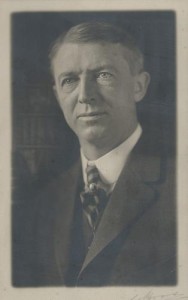
Minnesota Senator George Henry Sullivan, a Stillwater resident, is appointed Minnesota’s Lieutenant Governor upon the death of Governor Winfield S. Hammond and Lieutenant Governor J. A. A. Burnquist’s subsequent rise to the governor position. Sullivan continues to hold this position until January 2, 1917. Born in Stillwater in 1867, Sullivan had practiced law in the St. Croix Valley area before entering the Minnesota Senate in 1906, a post that he would retain until his death in 1935.
1917
May 5 – Washington County Protective League is Formed
The Washington County Protective League is organized in order to guard the loyalty of the county with “the jaws of a lion and the eyes of an eagle.” It is headed by Colonel Bob Wilkinson during the World War I era of suspicion and possesses a mission to seek out all spies. However, no spies are found in Washington County.
July 14 – Dellwood Incorporated as a Village
The Washington County portion of Barnum’s plat joined with the peninsula, Grove Park, the yacht Club Division, Dellwood Heights, and most of Boeckmann estate to form a single political entity. Dellwood residents had no desire to create a miniature St. Paul. There was no mayor, only a council consisting of a president and three trustees. The first president was Louis Rohlfing, a small farmer and landowner who operated an icehouse.
July 15 – Company K is assembled for World War I
Washington County’s National Guard unit, Company K is called upon after the United States declares war on Germany. Because the company only possesses 20 men, three recruiters travel the county in search of volunteers. The company is eventually assembled at the Stillwater Armory with a total of 150 men.
October 14 – Stillwater Wins Interstate League Championship
The Stillwater Baseball Club defeats New Richmond to win the Interstate League Championship. That entire season, the two teams had seemed nearly equal and advanced to face each other in the championship. The winner needed to win two out of the three games in the championship series. Each of the teams won one of the first two games. In the final game at the Interstate Park in Stillwater, the home team barely edged ahead of their opponent, winning the league championship. This caused much celebration in Stillwater.
1918
February 24 – Sugar Rationing
Because of the America’s involvement in the war in Europe, Minnesotans are asked to limit sugar to three pounds a month per person and sugar is ordered to be sold only in five pound bags, with the grocers in charge of bookkeeping.
November 18 – Influenza Epidemic Subsides
Schools reopen as the influenza epidemic also known as the “Spanish Flu” begins to subside. The epidemic had reached Washington County in October and resulted in the quarantine of 300 houses with at least six deaths reported. During this outbreak, 180 prisoners and 50 guards at the South Stillwater prison contracted the disease. In addition, one hundred men at the Twin City Forge Company in Stillwater fell ill.
December 7 – Lincolntown Separates from Grant Town
Due to apparent separate legal entities, it was necessary to draw up a petition to create separate voting precincts.
1919
May 29 – Patent of First Pop-Up Toaster
Frustrated by the burnt toast served in his company cafeteria, master mechanic and Stillwater resident Charles Strite begins to experiment with alternative ways to make toast. The result is the invention of the very first pop-up toaster for which he receives patent #1387670.
1920
January 5 – Farmers’ Terminal State Bank of Newport Opens
The Farmers’ Terminal State Bank of Newport opens in affiliation with the Farmers’ Terminal Meat Packing Company. A large corporation, the Company plant and stockyards cost $500,000 to build with a maximum capacity of 500 cattle and 4,500 hogs. Despite ambitions of building a tannery, a soap factory, and an oleomargarine plant, the Company collapses during the farm depression of the early 1920’s and declares bankruptcy in 1923. However, the bank continues to operate for another 50 years.
August 17 – Gustav A. Lund Receives Patent
Norwegian emigrant and Stillwater citizen Gustav A. Lund receives a patent for his new padlock. The lock is cylindrical in shape with a “slit-shaped key hole in one end.” He receives the patent #1349682.
1922
September 26 – Bayport Named
South Stillwater changes its name to Bayport.
1923
June 22 – Prescott-Point Douglas Bridge Opens
1928
July 6 – Machinery Delivered by Shaw-Enochs Company
The Shaw–Enochs Company delivers their first load of machinery. Following the burning down of their original plant, the Shaw–Enochs Company had purchased the old prison boiler house, twine factory, and shoe factory buildings for their purposes. They would prove to be a prosperous machinery manufacturing business in the post-lumber era Stillwater.
October 27 – Stillwater Ballpark in Poor Condition
The Stillwater Daily Gazette states, “The ball grounds in Stillwater have long been a disgrace to the city. The fence is in bad condition. The stands are rotting away and the grand stand became so bad recently that it had to be torn down. The field is so rough and in such a bad condition that skilled play is nearly impossible.” Fortunately, a group of high school students soon begins to raise money for the purpose of constructing a modern athletic field. It is at this location that the Stillwater Football team plays its early games.
1931
July 1 – Stillwater Lift Bridge Opens
In 1931 the much-rebuilt wooden Stillwater-Houlton bridge was at last replaced. For more than 30 years the city fathers had been saying a new bridge was needed, but they discovered that talk doesn’t build bridges. The Minnesota Highway Department took over the old pontoon swing bridge in 1925; by 1928 the old wooden span had so far deteriorated that it had to be closed to heavy traffic. Problems arose over who would pay for a new bridge and where it should be located. At last, State Senator George H. Sullivan of Stillwater solved the legal and financial problems by taking the project to the interstate level. Mostly due to his efforts, work on the new bridge began in 1930. The new bridge was designed to be a vertical lift bridge. Swing spans like the old bridge were considered outdated because they took up too much room. In addition to a counterweighted, tower-and-cable lift span, the new bridge included nine steel trusses, in all spanning just over 1,000 feet. The remaining 800-foot width of the river was covered by an earthen causeway built out on the Wisconsin side. This had the effect of reducing the grade as well as the costs. The bridge opened on July 1, 1931. The first person to cross the bridge was young Topper Jackson of Stillwater, who bicycled across as soon as the barriers were taken down at 10:05 a.m. The total cost of the project was $460,000, shared equally by the state of Minnesota and Wisconsin.
November 7 – Scandia Community Fair
Despite the hardships during the Great Depression, the Scandia community puts on a fair. Featured at this event are calves, crops, culinary displays, and $45 in premiums. Another popular attraction is the ten cent lunch.
1932
July 9 – Gangsters in Mahtomedi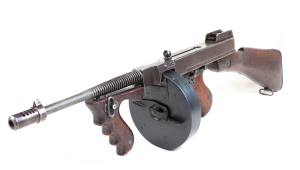
Freddie and Kate “Ma” Barker, Alvin “Creepy” Karpis, and a couple other well-known gangsters rent a house on the east shore of White Bear Lake in Mahtomedi. They live there quietly, going elsewhere to pull bank jobs. Later that summer, Freddie, Alvin, and Larry “the Chopper” De Vol make a quick trip to Concordia, Kansas to rob a bank of $22,000. The gang leaves Mahtomedi promptly, with the FBI showing up forty-eight hours later to find an empty cottage.
August 10 – Last Streetcar in Stillwater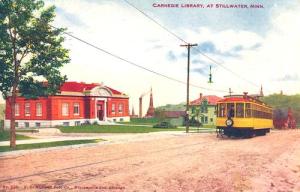
The last streetcar in Stillwater arrives at the Union Depot where it is decorated with black crepe. Led by the city band playing a funeral tune, it then proceeds to Main and Chestnut Streets where first Stillwater streetcar motorman Jerry Hagerty is presented with a large spray of flowers. With 50 Stillwater residents on board, the streetcar proceeds on its final trip to St. Paul. On the way, it stops at the Wildwood station where it is serenaded by the White Bear band playing several songs, ending with all bystanders joining in on the chorus of “Goodbye Forever.” The streetcar’s arrival in St. Paul marks the end of the light rail service in Stillwater.
1934
April 1 – End of the Civil Works Administration
The Civil Works Administration (CWA) ends due to lack of funds. Started as part of President Roosevelt’s New Deal, the CWA provided construction jobs for the country’s unemployed. Before the creation of the CWA, there were about 500 unemployed Stillwater citizens. Once the CWA reached Washington County, it provided jobs for up to 550 men and 25 women in the area. Those employed by the CWA received wages ranging from 55 cents an hour for common labor to $1.20 an hour for foremen.
April 11 – Washington County Historical Society Formed
Founded April 11, 1934, the Washington County Historical Society is a private, non-profit educational institution with about 700 members. There are two membership meetings held annually during the late summer and late winter. The society operates two museum sites, each with two structures. The society’s research library has been growing since that first meeting in 1934. It is housed in the reconstructed carriage house behind the Warden’s House Museum. The WCHS endowment fund was established in 1984 to provide a source of funding for everyday administrative and operating expenses.
In the early years of the society, the membership meetings were held at the Stillwater Public Library. The first society president was Edward E. Bloomquist, who was also the county school superintendent. The first donation to the society was the book History of Washington County and the St. Croix Valley by Warner and Foote.
May 22 – Roxy Road Show Comes to Minnesota Theater
Samuel Lionel “Roxy” Rothafel brings his traveling show to the Minnesota Theater in Minneapolis. A Stillwater native, Roxy’s family moved to New York when he was twelve. As a young adult, he made his first venture into the young motion picture industry by opening a theatre in Pennsylvania. He gradually worked his way up the show business ladder, gaining popularity by presenting a unique combination of vaudeville stage shows, movies, and razzle–dazzle. He continued on to build the majestic Roxy Motion Picture Palace in New York, design Radio City Music Hall, and bring the world the Rockettes (originally Roxiettes) dance troupe. When he brings his traveling show to Minnesota, 500 Stillwater citizens form a 125–automobile caravan to his Minneapolis performance. It is said that in 1930’s Stillwater, Roxy is as well known as Franklin D. Roosevelt.
June 1 – First Lincolntown High School Graduating Class
First graduates from the High School Graduate, at which time there were 16 graduates.
June 22 – John Dillinger in Washington County
John Dillinger, the most notorious gangster in the country, hides out at Crocus Park in Bayport. While waiting for a report from his cohorts regarding crossing into Wisconsin on the Hudson or Stillwater bridges, he is discovered by Washington County Sheriff Thomas Maher. However, before authorities are able to surround the area, Dillinger slips away, escaping arrest.
October 1 – Election of First WCHS Officers
The first officers of the Washington County Historical Society are elected. E.E. Blomquist is elected president and Mrs. W.C. Masterman and Gertrude Glennon are appointed as first and second vice presidents. The first secretary is Robert Harrigan and the first treasurer is Annie Connors. Council members are also selected from the towns of May, Forest Lake, Stillwater, Bayport, and Cottage Grove. The early meetings of the Society are held in various locations within Washington County and include a presentation on the history of that location.
1935
December 7 – Washington County Power and Light Association Organized
The Rural Electrification Act allows for the organization of the Washington County Power and Light Association. The Association is organized by 357 farmers and rural residents. Within two years, construction of electrical lines begins in the northern part of Denmark Township and parts of Afton and Woodbury not already covered by the existing electrical grid.
1939
August 24 – Founding of Northwestern Oil Refinery
The Northwestern Oil Refinery is founded in St. Paul Park by the seven Erickson brothers. It starts out as a 5,000-gallon a day plant with 25 employees. The Ericksons also own forty gas stations in the Upper Midwest and import their oil from Illinois by rail. The company is purchased in 1970 by Ashland Petroleum, and is now owned by Marathon with the capability of processing 70,000 barrels of petroleum product per day.
September 23 – Dedication of Battle Monument
A monument is dedicated commemorating the 100th anniversary of the battle between the Ojibwe and the Dakota in “Battle Hollow”, a ravine just north of Stillwater. The monument is erected by the National Youth Administration (NYA) in partnership with the State of Minnesota and the City of Stillwater. Father Philip Gordon, a full–blooded Ojibwe, delivers the dedicatory address. He, along with other Ojibwe, then sits down with members of the Dakota nation to smoke the pipe of peace, reconciling the two nations after 100 years.
1940
January 2 – H.C. Robertson Urges WCHS to Purchase Warden’s House
H.C. Robertson learns that the Warden’s House is to be disposed of by the state and writes a letter to then WCHS President E. L. Roney, which says:
“Due to the fact that it is impossible for this Department to dispose of State property without an act of the Legislature, I have received the approval of the Governor to lease the old warden’s home at Stillwater, to your Society, at a small rental fee of $10.00 per month. It will be necessary, of course, that the Society maintain the building in first class condition…I would suggest that you have your Senator of Representative introduce a bill in the Legislature to either sell this property to your Society or lease it to you on a long term basis.”
1941
April 9 – WCHS Obtains Warden’s House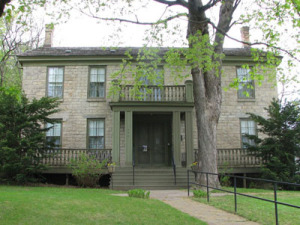
A deed is signed which gives the Warden’s House to the Washington County Historical Society. This occurs as the result of a bill prepared by Chester Wilson and presented to the Minnesota legislature by Karl Neumeier and Rollin Johnson. The bill passed both houses and Governor Harold Stassen signed the bill.
October 5 – White Bear Devastated by Tornado
The worst storm in White Bear’s history leaves destroyed houses and hundreds of trees blocking streets in its wake. The National Guard is called to help direct traffic and aid in the recovery.
“The rain fell in such torrents vision out a few feel impossible. A howling, raring wind as of a gigantic monster accompanied it. The air was filled with debris, great trees by the hundreds were uprooted or split, twisted and thrown in every direction.”
Fifty White Bear residents were injured and three were killed in the chaos.
November 23 – Mahtomedi Superintendent
“Harry E. Rumple who is beginning his fourteenth year as superintendent of the Mahtomedi school, has seen an institution expand from an eight-teacher grade school into a modern system embracing kindergarten, grade and complete high school and employing 17 faculty members.”
1943
January 5 – Reuben Granquist Begins Tenure as Sheriff
Reuben Granquist begins duties as sheriff of Washington County. Born in Stillwater, Reuben spent much of his childhood in St. Paul following his father’s death. Upon reaching adulthood, Reuben was appointed game warden for part of Ramsey County and the northern part of Washington County. Reuben was later appointed game warden for all of Washington County, a position which he held for several years. After winning his initial election as sheriff of Washington County, Reuben would continue to serve in this position for 27 years, seeking and winning re-election seven times.
1947
January 7 – Airport Denied Relicensing
During World War II, North Port, a small airfield on Route 96 just east of Dellwood, was a used as a training site for French pilots. After the war, the airport became a bone of contention for locals because of excessive noise.
Modern
1948
August 26 – 100th Anniversary of Stillwater Convention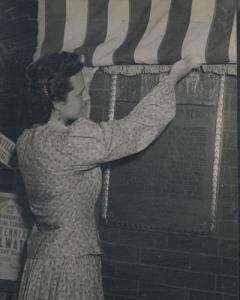
A plaque is placed on Main Street commemorating the 100th anniversary of the Stillwater Convention. Susan Stephan has the honor of performing the ceremonial unveiling.
1956
April 21 – New Telephone Company Building
The telephone company in Stillwater lays the cornerstone for a new building located at 302 South 2nd Street. This is the result of a need to expand after over seventy years of telephone service in Stillwater. A large ceremony is held, and Stillwater Mayor Andrew Madsen says that the building’s construction is, “a great event in the telephone history of Stillwater and a fine addition and improvement to our beautiful city.” The building is completed the following year.
1957
October 28 – Rich Man Calls Washington County Home
According to Fortune magazine, William L. McKnight, chairman of the Minnesota Mining and manufacturing Co. McKnight resides in Dellwood. McKnight considered to be in the top 76 richest men in the nation. McKnight’s fortune at the time was estimated at $100,000,000 to $200,000,000 bracket.
December 23 – High School Fire Loss $250,000
A fire on Monday, December 23 destroyed the old east section of Stillwater High School and heavily damaged the newest section on the west. A few days later, a defective furnace stack was officially determined as the cause of the $250,000 Senior High School fire. Richard Braun, assistant state fire marshal, reported that the fire was accidental and caused by a unlined and unsafe chimney.
According to Supt. Earl Vitalism “The loss is fully covered by insurance. There was $130,000 coverage on the old building and $800,000 on the newer one.” The fire was discovered at 6 pm and was the most spectacular the city has ever seen and was the largest loss since the Gilbert plant tire of May 16, 1955. “By the time the first pumper reached the scene the old building was an inferno and the blaze raged furiously for an hour. A brisk northwest wind fanned the fire and filled the air with blazing embers that floated over the Junior High School and several frame houses along Pine and Third streets.” In all it is estimated 90 firemen and volunteers fought the fire. A total of 1,142,250 gallons of water was poured n the fire. The fire was visible for many miles, as far away and Willernie and hundreds of people in the surrounding area drove into Stillwater to view the blaze. The school itself was 87 years old. Graduation records form the last five years were lost along with 3,000 books from the library.
1965
April 18 – Record St. Croix River Flooding 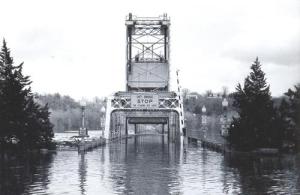
The St. Croix River crests at 94.10 ft. at Stillwater, the highest recorded river level. Everyone from high school students to prison inmates is called upon to help fight the rising waters.
September 8 – First Cottage Grove Council Meeting
Formalities of the meeting included the taking of oaths for the public offices to be held by the new officers. The first order of business was to establish a meeting night which would be agreeable to most member of the new council. Another action of the board was to designate the South Washington County Bulletin the legal paper for the Village of Cottage Grove.
September 14 – Cottage Grove Promotes Patrolman 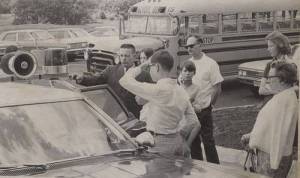
First official act of the Cottage Grove village council was to promote Patrolman Eugene Lee from a part-time to full-time officer. Lee’s promotion increases Cottage Grove police force to 3 full time officers, including Robert Oszman (in photo), acting chief. Hired at a salary of $450 a month, with a 6-month probationary period.
November 5 – Proposal for “Washington” Megalopolis Rejected
Voters reject the proposal for the merger of Woodbury and Cottage Grove into a megalopolis to be called “Washington”.
1966
January 26 – Regulation of Beer Sales
The established regulations cover both on-sale and off-sale beer. A basic part of the ordinance is the requirement of a license to sell beer or non-intoxicating liquor.
March 2 – Northwestern Bell Telephone Project
Northwestern Bell Telephone announced plans for a new $2,250,000 central office to serve Cottage Grove and St. Paul Park suburban areas. The first step will be construction of a 6,400 square foot, one story masonry and brick building on Cottage Grove Road about one-half mile east of Highway 61. Special apparatuses will be installed to permit automatic identification of numbers and touch-tone calling.
July 20 – Cottage Grove Leads in Population
Washington County shows steady growth in the last six years, according to Metropolitan Planning Commission report this week. The county gained 2,832 in population. Cottage Grove Township is leading the county in new people, with 4,850 making it the biggest community in Washington County. Stillwater is now in second place.
1967
February 14 – Proposal for Woodbury Village Approval
Voters approve a proposal to incorporate the township Woodbury as a village. This move is initiated by the Jaycees, led by its president, Stanley Olander and its director of government affairs Craig Jilk. The Jaycees promote their proposal by stating that, “Woodbury needs and deserves a form of government which can handle the inevitable problems of growth.” The Woodbury Bulletin reports that “Most remember the transition from town to village as a smooth one.”
1975
July 12 – Opening of Johannes Erickson Log Cabin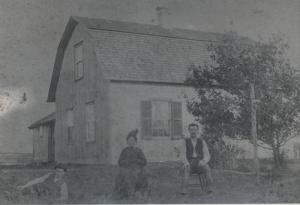
The Johannes Erickson log cabin is opened to the public by the Washington County Historical Society. This historic structure was originally built in 1868 by a Swedish immigrant and required three months of renovation before being hoisted on wheels and moved 1.5 miles to the Hay Lake area.
1976
November 6 – Engine 328 Leaves Stillwater
After being housed in Stillwater’s Lowell Park for over twenty years, Engine 328 is transferred to the Como Shops of the Burlington Northern. Originally built in August 1905 by the American Locomotive Company’s Rogers plant in Paterson, New Jersey, Engine 328 was purchased by the Northern Pacific (NP) in 1907. The Engine was assigned to NP’s Minnesota Division and ran until June 1950. It’s ownership was then transferred to the Minnesota Railfans Association, who housed it until 1955 when the Engine was placed in Stillwater for people to observe and learn about the railroad’s past. Upon its relocation to the Como Shops, the Engine enjoyed a complete restoration including a major overhaul of its boiler.
Engine 328 is currently located at the Minnesota Transportation Museum.
1979
August 4 – Little Red School House on Fire
Little Red School House on Rum River Road (now Highway 96) was suspected to be the first school in the area. The school remained in use until 1930 where it was restored and used as a town hall and activity center. This historic landmark was damaged by fire on August 4th, 1979.
1982
January 22 – Brine’s Fire
Two Mahtomedi firefighters lose their lives in the Brine’s Meat Market fire. It is the worst loss of life in a fire in over 75 years.
1987
May 6 – History Foundation to be Formed
Residents of White Bear Lake organize historical foundation and endowment fund which would provide funds to acquire, maintain, record, and promote significant historic places. Those in attendance on Tuesday, April 28th discussed whether the organization should be called “The Lakes Area Historical Foundation” or “The White Bear Lake Area Historical Foundation.” The name would be left up to the board when it was formed. Construction of a museum for artifacts as well as boat museum were included on the wish list. Other goals include published histories as well as filming interviews with long-time residents.
1990
January 20 – Removal of Stillwater Parking Meters
The parking meters of Stillwater collect their last money as they are sold for $10 each at the city garage. Having served Stillwater since the late 1940’s, the meters are replaced by pay lots.
2002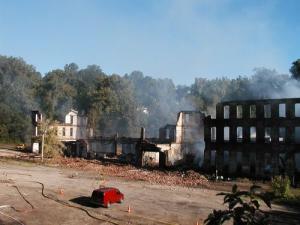
September 3 – Territorial Prison Fire
The remaining buildings of the old Stillwater Prison on North Main Street are destroyed by arson. They are replaced by the Terra Springs condominiums.
2012
March 14 – St. Croix River Crossing Act Signed Into Law
After passing through the House and receiving unanimous approval in the Senate, President Barrack Obama signs the St. Croix River Crossing Project Authorization Act. This project is the culmination of half a century of debate and discussion regarding the fate of the Stillwater Lift Bridge. The old bridge is to be converted into a pedestrian crossing and a new, modern bridge will be constructed farther south on the river in an attempt to alleviate the severe traffic in downtown Stillwater. The Washington County Historical Society purchases the old UFE Building on Greeley Street South and leases the property to MnDOT to use as their construction headquarters.
2021
The Washington County Historical Society finishes renovations on the old UFE Building and opens the brand new Washington County Heritage Center to the public on October 16, 2021. The Heritage Center also includes an Education Center for programs and events and a Research Center for Washington County history.
Pioneer Era Territorial Period Early Statehood Lumber Era World Wars Modern
